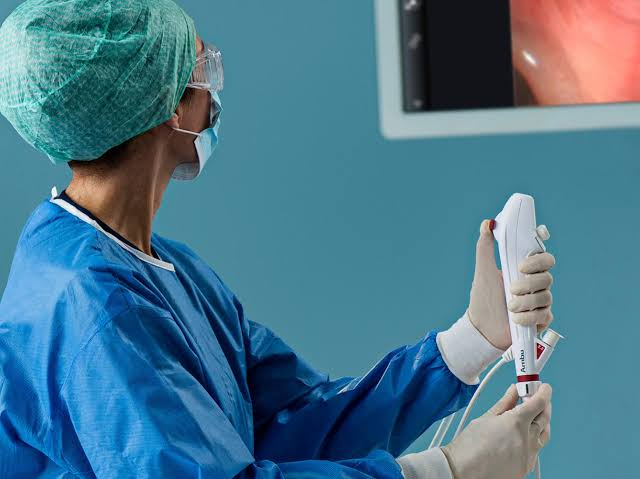
Bronchoscopy
Bronchoscopy is a diagnostic and therapeutic procedure used to examine the inside of the airways and lungs. During this procedure, a bronchoscope—a flexible tube equipped with a camera and light—is inserted through the nose or mouth and guided into the lungs. This allows healthcare providers to visualize the airways, take tissue samples, and perform certain treatments.
Signs and Symptoms Indicating a Need for Bronchoscopy
A bronchoscopy may be recommended if a patient presents with:
- Persistent cough
- Unexplained hemoptysis (coughing up blood)
- Difficulty breathing or wheezing
- Abnormal chest X-rays or CT scans
- Suspicion of lung infections or tumors
- Foreign body aspiration
Types of Bronchoscopy
- Flexible Bronchoscopy: Utilizes a flexible bronchoscope and is commonly used for diagnostic purposes. It is less invasive and allows for better maneuverability within the airways.
- Rigid Bronchoscopy: Involves a rigid metal tube and is often used for therapeutic procedures, such as removing large obstructions or performing surgeries.
Diagnosis
Diagnostic Uses:
- Persistent or Unexplained Cough: To investigate the cause of a chronic cough that does not respond to standard treatments.
- Abnormal Chest X-rays: When imaging shows lung inflammation, consolidation, masses, or nodules that need further evaluation.
- Hemoptysis: When blood is present in the sputum and requires investigation.
- Potential Lung Infection: To assess and identify the cause of a suspected lung infection.
Therapeutic Uses:
- Foreign Body Removal: To extract objects that may have been inhaled and are obstructing the airway.
- Airway Stenting: To place a stent in cases where the airway is collapsed due to pressure from a tumor or mass.
- Growth Removal: To remove any obstructions or growths blocking the airway.
Treatment
- Debulking Tumors: Removing or reducing the size of tumors within the airways.
- Treatment of Bleeding: Controlling bleeding within the airways through cauterization or other techniques.
- Airway Stenting: Placing stents to keep airways open in cases of obstruction.
Medications
While bronchoscopy itself does not involve medication, pre-procedure medications may include:
- Sedatives: To ensure the patient is comfortable and relaxed during the procedure.
- Local Anesthetics: To numb the throat and airways.
- Need Few Hours fasting before Procedure.
What Is the Procedure for Bronchoscopy?
During a bronchoscopy, the following steps are typically followed:
- Preparation: The patient is made comfortable and relaxed, often with the help of sedatives.
- Insertion of the Bronchoscope: The bronchoscope, a thin, flexible tube with a camera, is inserted through the patient’s nose. It is then guided down the throat and into the bronchi, the airways within the lungs.
- Sample Collection: The bronchoscope may be equipped with tools such as needles or brushes to collect tissue samples from the lungs. These samples help in diagnosing various lung conditions.
- Bronchial Washing: A saline solution may be sprayed over the surface of the airways to collect cells. The washed cells are then examined under a microscope. This technique helps in identifying:
- Mucus
- Blood
- Swelling
- Blockages
- Infections
- Tumors
- Treatment (if needed): If the airways are blocked or narrowed, a stent may be placed to keep the airway open. The stent is inserted using the bronchoscope.
- Completion: Once the examination and any necessary treatments are completed, the bronchoscope is carefully removed.
Bronchoscopy provides valuable insights into lung health and is crucial for both diagnosing and managing respiratory issues effectively.
FAQs
You may need to fast for several hours before the procedure. Your doctor will provide specific instructions based on your health condition.
Most patients experience minimal discomfort during the procedure, as sedatives and local anesthetics are used. Some soreness or throat irritation may occur afterward.
A bronchoscopy typically takes about 15 to 30 minutes to an hour, depending on the complexity of the procedure.
While generally safe, bronchoscopy carries some risks, including fever, bleeding, infection, or an adverse reaction to anesthesia. Your healthcare provider will discuss these risks with you.
Recovery time is usually short. Most patients can resume normal activities within a day or two, though your doctor may provide specific guidelines based on your case.
Results from a bronchoscopy can be available within a few days, depending on the tests performed and the need for additional analysis.
Conclusion
Bronchoscopy is a valuable tool in diagnosing and treating various respiratory conditions. If you have concerns or symptoms that may require a bronchoscopy, consult with your healthcare provider to determine if this procedure is appropriate for you.


